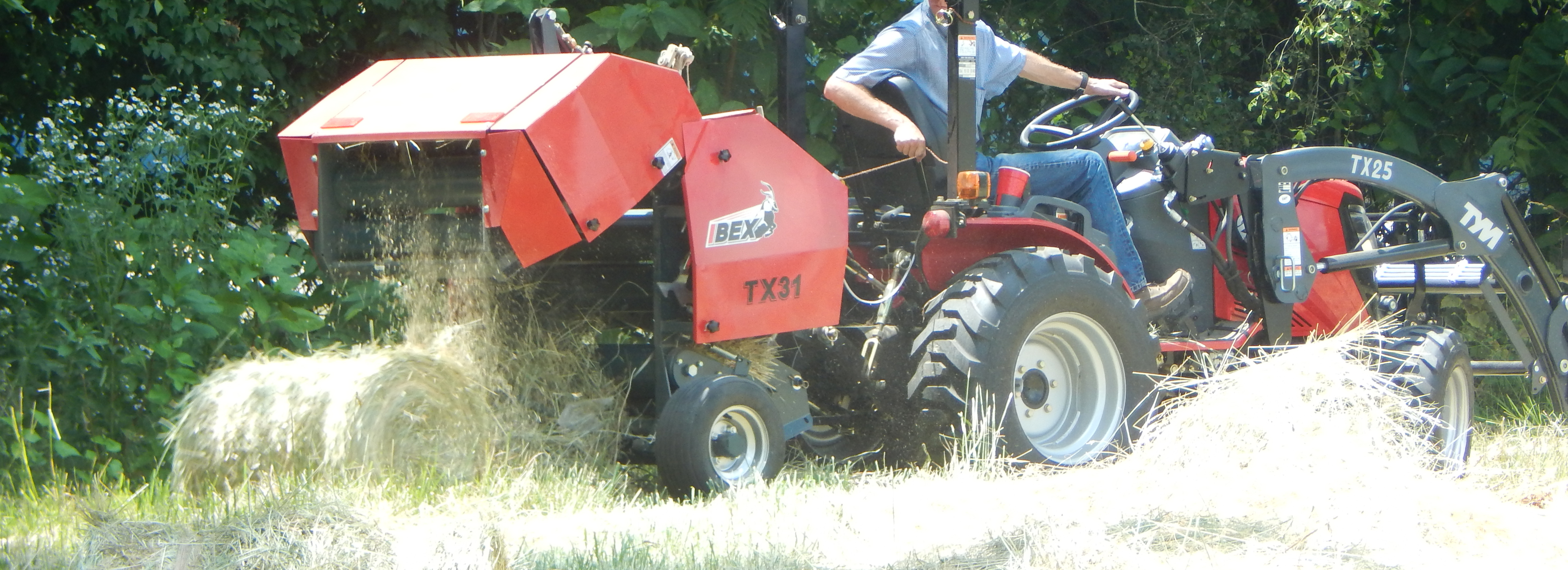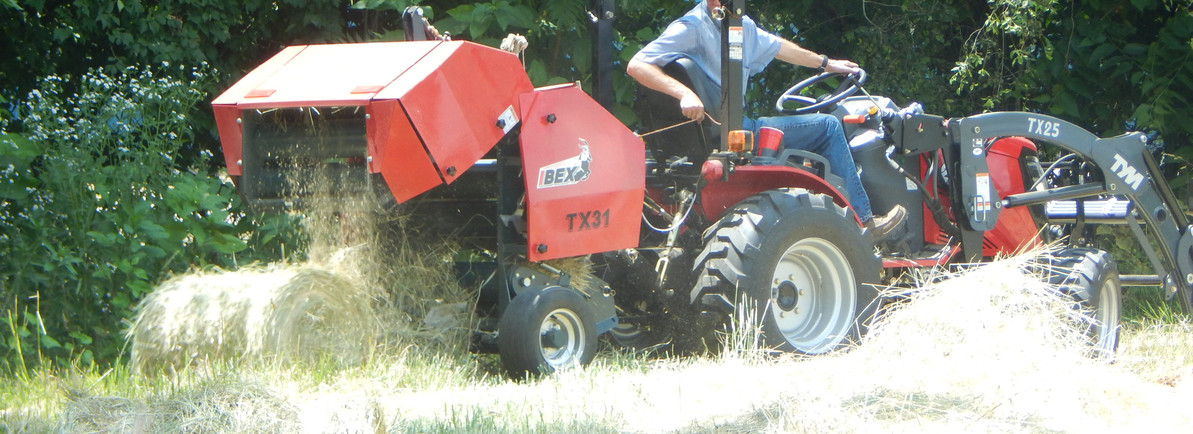Hay Day with your Ibex TX31 Mini Round Baler

The pasture has been cut, dried, and raked into windrows. It's hay day! Here are some tips to make baling day with your Ibex TX31 Mini Round Baler run smoothly.
Before heading to the field:
- Baling days are typically hot days, so dress in lightweight, light-colored clothing. Long sleeves and long pants are best for protecting your arms and legs from cuts and scratches when collecting bales. Be sure to bring along a large water jug so you can stay hydrated.
- Pack a tool kit with spare parts to take to the field with you. This will save time during any breakdowns. Include tines, shear bolts, and the tools needed to make repairs.
- Build an extra day into your schedule if possible in case of poor drying conditions or other unforeseen issues.
When you first reach the field:
- Check the moisture levels of your hay one last time. Hay that is too moist when baled will mold. You can do this by use of a moisture probe or by giving it a quick “twist test”. To do this, simply grab a fistful of hay and twist it with a circular motion. If the stems break easily, the hay is cured. If they bend, it is not.
- Check your windrows. Consistent windrows lead to uniform bales. The largest windrows the baler can handle will allow the baler to perform more efficiently and also minimize leaf loss.
- Ensure that the baler’s tines are about 1” off the ground. This reduces dirt contamination of the baled hay and reduces baler wear and tear since stones aren’t as likely to be picked up. If you are unsure of how to adjust the height of the tines, refer to your manual for guidance.
As you begin baling:
- Expect the need to tweak the baler during the first few minutes of baling, especially the first time out in the field each season. Every hay crop is different, and the baler will need to be adjusted accordingly.
- Adjust your driving speed to match the baler pickup speed. A properly fed baler will reduce the time it takes to bale while improving bale quality and consistency. Also note that larger windrows will require slower driving speeds.
- Get off the tractor after the first few bales and check bale density and shape. Also check to see if net wrap/twine is wrapping correctly. Doing this will lead to bales that preserve better and retain quality. Bales that are properly wrapped and of optimum density will be better protected from weather and easier to transport and store.
At the end of the day:
- Always clean up your baler when you’re finished baling. Remove any hay in the bale chamber. Check to make sure the pickup is clear and nothing is wound around the tine bars.
- Use compressed air, not water, to clean the gears, chain, and other moving parts.
- Oil chains as necessary with an appropriate chain lube. Hit all grease zerks.
- Store the baler in a dry environment. Doing this will not only ensure the baler is ready to go the next time you want to use it, it will also reduce the opportunity for rust to form on unpainted parts, prolonging the life of your baler and ensuring peak performance.
- For end-of-season tips for storage, click here.
Answers to general questions you may have:
How many bales per hour should I expect my TX31 to produce? If your TX31 is the twine wrap model, you can expect it to average approximately 80 bales per hour in good conditions. If your TX31 is the net wrap model, you can expect closer to 100 bales per hour. The difference in production rate is due to the number of times the bales are wrapped in the chamber. Twine bales are wrapped 8-10 times while net bales are wrapped only twice.

How fast can I drive the baler? How do I tell if I am at the right speed? The baler should appear to be pulling the hay into the machine, almost as if it is a vacuum cleaner. As long as the pickup tines are keeping up with all the hay in front of the baler, speed can be increased. Overloading the baler, however, can lead to the machine jamming and the potential for broken shear bolts.
What travel pattern should I use while baling? Depends on the field. Mini round balers are super-maneuverable. When you get to the end of the row, the baler can simply be picked up to make a tight turn and head down the next row. If your tractor won’t pick the baler up off of the ground, or if you are using a baler with a drawbar, your turning radius may be restricted. In that case, skip a row so you can make a more gradual turn. If you are baling particularly small windrows, weave back and forth over the windrow so both edges of the baler receive hay. This will result in a more consistently cylindrical bale.
How do I safely bale on hilly ground? In hilly locations, we recommend baling along the contours. This will prevent bales from rolling downhill or getting caught under the baler. Always keep the baler on the ground when baling on hills, and take your time, especially when going downhill.
How do I reduce chaff? 1. Don’t let your hay get too dry before baling. 2. Handle your hay as little as possible. Each time you move the hay, whether with a rake, a tedder, or the baler, some breaking of the stems and leaves will occur. 3. Make sure you have good weather for making hay. If you cut the hay and then it gets rained on, you will have to spread it out with a tedder to dry, and then re-rake. Each time it re-dries it will become more brittle. The good news is that mini round bales will have less chaff because the baler does not chop the hay the way a square baler does with each compression stroke.
How should twine or net wrap feel if it is at the correct tightness/density? Bale density is a matter of personal preference. However, the outside of the bale should feel tight - it should be difficult to push your finger into the bale. Depending on the density of the bale, the core of the bale will still be soft. This type of bale will be very weather resistant, since the outside of the bale will shed water (think of a thatched roof) while moisture in the core of the bale can still escape.
How do I adjust bale size and density on my Ibex baler? The density (and weight) of bales is easy to adjust on Ibex balers. The manual provides step-by-step instructions. Adjustments can be made in the field without tools, so it’s easy to fine-tune for your specific conditions as you bale.
How do I stack mini round bales on a wagon and in the barn? Mini round bales will stack tightly on a trailer or in a barn, so long as they have some end support at the bottom of the stack. Each row will nestle between the bales of the row below, in a honeycomb-like pattern.
For more information on Ibex balers please visit our website tractortoolsdirect.com or give us a call at 1-260-BALE-HAY today.
Sources
https://www.drovers.com/article/baling-tips-superior-hay-quality
https://www.hobbyfarms.com/baling-hay-safe-efficient-tips/
Recent Posts
-
Boost Pine Straw Production Efficiency with Ibex Mini Round Balers
At Tractor Tools Direct, we're known for our high-quality hay equipment tailored for small farms …Dec 8th 2025 -
How to Winterize Your Tractor: Essential Maintenance Tips to Protect Your Investment
Farm equipment is one of the most valuable investments a farmer can make. At Tractor Tools Direc …Dec 1st 2025 -
Farm Tax ID Explained: Benefits, Eligibility, and How to Apply
As the end of the financial year approaches, it's a great time for small farmer operators to rev …Nov 12th 2025




